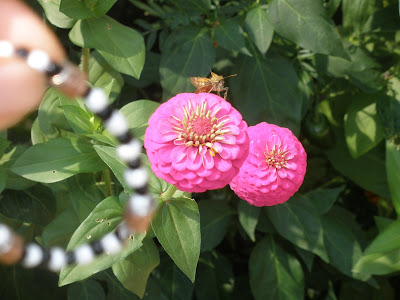This little friend looks like a Monarch butterfly but the truth is that this fellow is a Viceroy.
This viceroy have adapted the colors of a butterfly so he can protect himself from predators.
This viceroy have adapted the colors of a butterfly so he can protect himself from predators.
Most of the time the conifer leaf looks like a needle and stays green for a long period of time. The conifer seeds are protected by cones. These protective cones are hard and woody; they take from four months to three years to reach maturity.When is is mature the scales usually spreads open allowing the seeds fall out and be dispersed by the wind.
Commensalism
 Commensalism is a type of symbiosis, a biological relationship in which one species benefit from an interaction, while the host species is neither positively or negatively affected to any tangible degree.
Commensalism is a type of symbiosis, a biological relationship in which one species benefit from an interaction, while the host species is neither positively or negatively affected to any tangible degree. These pictures shown a commensionalism between the butterfly and the flower, because the butterfly is getting its meal from the flower while the flower's phloem gets spread to others flowers.
These pictures shown a commensionalism between the butterfly and the flower, because the butterfly is getting its meal from the flower while the flower's phloem gets spread to others flowers. Deciduous leaf
 Deciduous are those types of leaves that fall off the tree in certain season. When these leaves fall off is because they finish their purpose.
Deciduous are those types of leaves that fall off the tree in certain season. When these leaves fall off is because they finish their purpose.This red maple leaf will fall off its tree when the fall comes; that is the reason for which it is a good example of a deciduous leaf.
Dicot Plant

Dicot is a subdivision of flowering plants whose members posses two embryonic seed leaves, or cotyledons.
Flowering plants are divided into two monocots and dicots.
As we can observe dicots's veins in leaves are usually net like; their flower is usually divided in four or five parts; they posses two cotyledons, and the arrangement of of primary vascular bundles in steam looks like a ring.
Exoskeleton

Exoskeleton is a hard encasement on the surface of an animal, such as the shells of mollusks or the cuticles of arthropods, that provide protection and points of attachment for muscles.
This little fellow looks like from the zopheridae family.
This fellow body is hard so that it becomes like a shell over the insect's body. Since insects do not have bones, the shell works as a body skeleton, and since the skeleton is outside the body we called it exoskeleton.
This exoskeleton help our little fellow to protect itself from predators but as any other organism they grow; therefore they need a new exoskeleton, that is why at certain period of time they have to change t heir exoskeleton. When the insect grows the exoskeleton actually splits open and let out the new enlarge version of the insect out, leaving the old exoskeleton behind. But unfortunately for our friend the new exoskeleton takes a while to harden, and during this time the insect is soft and very vulnerable against its predators.
heir exoskeleton. When the insect grows the exoskeleton actually splits open and let out the new enlarge version of the insect out, leaving the old exoskeleton behind. But unfortunately for our friend the new exoskeleton takes a while to harden, and during this time the insect is soft and very vulnerable against its predators.
 heir exoskeleton. When the insect grows the exoskeleton actually splits open and let out the new enlarge version of the insect out, leaving the old exoskeleton behind. But unfortunately for our friend the new exoskeleton takes a while to harden, and during this time the insect is soft and very vulnerable against its predators.
heir exoskeleton. When the insect grows the exoskeleton actually splits open and let out the new enlarge version of the insect out, leaving the old exoskeleton behind. But unfortunately for our friend the new exoskeleton takes a while to harden, and during this time the insect is soft and very vulnerable against its predators.Endotherm
Endotherm is an animal that uses metabolic energy to maintain a constant body temperature, such as a bird or mammal.
This is Snoopy, my cousin's dog, and since he is a mammal, he maintains a constant body temperature independent of the environment where he is located.
Since he is an endothermic animal he can control his body temperature. Most endothermic animals are able to survive in cold environments because of their ability to maintain body temperature above ambient temperatures in cool climates. Most of them use their body fat to control their body temperature.
Cambium

The cabium is a single layer of cells, called initial cells. The cambium originates from undifferentiated cells that have retained their embryonic capacity for continued growth and differentiation.

A cambium may also form within callus tissues, these are masses of cells that grow over the injured surface of a wound, leading to healing.
As we can see on these pictures the tree is divided into many layers. The first on is the heart wood, it is located right in the middle or center of the tree. The second layer is called sapwood, it is a thick layer that covers the heart or the tree. The third one is the cambium, which is a thin layer. Then we will found the inner and the outer bark.
It is important to know that in a case of a fire the cabium must survive the fire for the tree to survive. That is how important the cabium is for a tree.




No comments:
Post a Comment